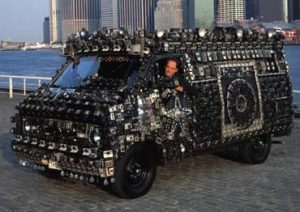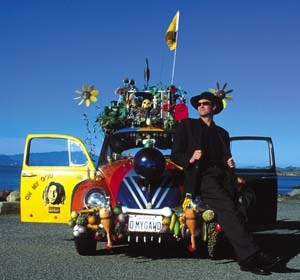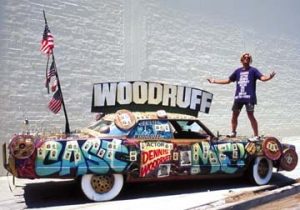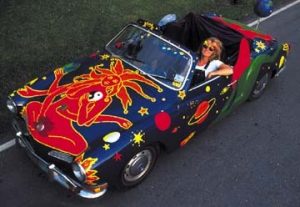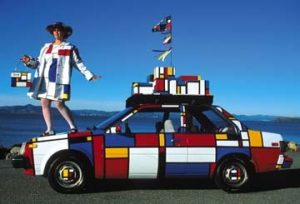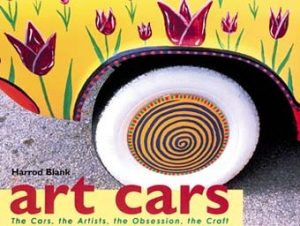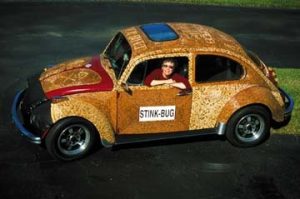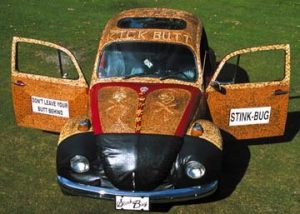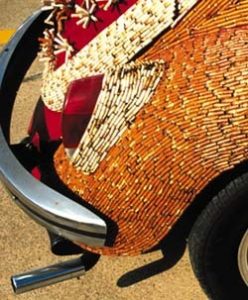Whether it’s painted, glitter-covered, shellacked, super-glued or sculpted, an art car is hard to miss. So, if you’ve seen one, you likely remember it. These unorthodox vehicles catch your eye because they’re obviously different and comparatively outrageous next to the cookie-cutter sedans and SUVs with which they share the road. You may have dismissed these vehicles (and possibly their owners) as just plain wacky, or perhaps their whimsy made you smile.
To Harrod Blank, an art-car enthusiast, these inventive vehicles are the artist’s means of self-expression — their intended expression is unique to the individual. Some artists move from the canvas to their car; others decorate their vehicles without previously creating artwork; others transform their vehicles as a catharsis; some just want to bring happiness to all who see the car; and still others seek to draw personal attention or publicize a message.
Blank, who lives in Berkeley, CA, created his first art car as a teenager by painting chickens and roosters on his bland 1965 Volkswagen bug. Growing up in a forest in the mountains near Santa Cruz, CA, with his artistic, hippie parents, Blank wanted to demonstrate that he was different.
Expressing his individuality on his car expanded with time. He later created other art cars, including the "Camera Van," which is covered in cameras — many still functioning — to capture on film the public’s response to the vehicle.
After college, Blank sought others who had also re-invented their vehicles. Connecting with fellow art-car owners, Blank created calendars, a book and a documentary on art cars. While promoting his book and film, both called Wild Wheels, Blank encountered art cars across the country. He’s currently working on another documentary film on the subject.
An art car invites public attention — whether or not its creator desires it, Blank said. "It’s like a performance. You are on display. People know where you go," he said. "It can be a fish bowl on wheels." But the car can also be a way to stir things up or make people happy when they spot your unique vehicle, he said. "I can’t tell you how many people have said to me, ‘This has made my day’."
Art cars have increased in popularity — Blank estimates that the number of art cars has doubled in each of the last few years — as evidenced by the related art-car events and parades that have cropped up. He estimates approximately 5,000 art cars in the United States. This cultural phenomenon tends to have a snowball effect. When one person creates an art car and begins driving it in a community, Blank said, the creative seed has been planted, and others inevitably follow.
Read More About It
In his latest book, Art Cars: The Cars, the Artists, the Obsession, the Craft, Harrod Blank features photographs of more than 100 art cars. Art cars aren’t just the work of career artists; the creators of these automobiles include a police officer, nuclear scientist, architect, actor and students. The vehicles are taken from the assembly line and given a unique existence enveloped in such items as pennies, myriad paint colors, wine-bottle corks, chalkboards, a working waterfall and various collections of knick-knacks.
To purchase the book, or for more information about Blank’s films and books, visit www.harrodblank.com. For more information about art cars, visit www.artcaragency.com.
Carolyn Stapleton tries to discourage litter with the "Litter-Bug," which she later transformed into the cigarette butt-covered "Stink-Bug" (below).
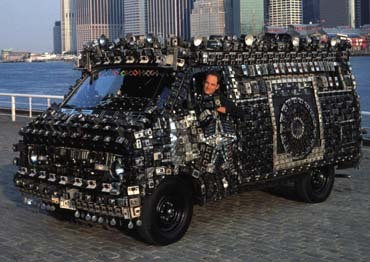

 Tip Sheet4 days ago
Tip Sheet4 days ago
 Business Management2 weeks ago
Business Management2 weeks ago
 Women in Signs2 weeks ago
Women in Signs2 weeks ago
 Real Deal5 days ago
Real Deal5 days ago
 Benchmarks24 hours ago
Benchmarks24 hours ago
 Editor's Note1 week ago
Editor's Note1 week ago
 Line Time2 weeks ago
Line Time2 weeks ago
 Product Buying + Technology1 week ago
Product Buying + Technology1 week ago
